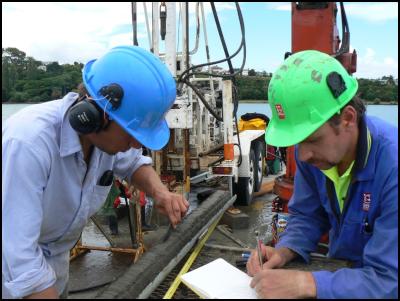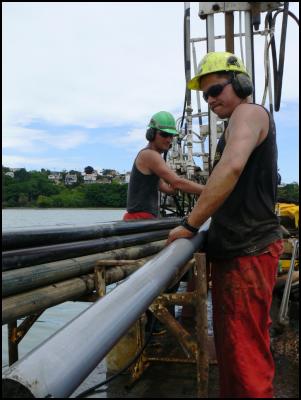Orakei Volcano is Much Older Than Thought
Scientists Find Orakei Volcano is Much Older Than Previously Thought

Click to enlarge
Dr Graham Leonard and Mike Rosenberg from GNS Science examining ash layers in core from Orakei Basin, Auckland.

Click to enlarge
ProDrill drillers James and Ray preparing to extract the core from a drill barrel at Orakei Basin, Auckland.
NEWS RELEASE
11 JANUARY
2007
SCIENTISTS FIND ORAKEI VOLCANO IS MUCH OLDER THAN
PREVIOUSLY THOUGHT
Scientists drilling into the Orakei Basin in Auckland have found the Orakei volcano is probably three times as old as previously thought.
A group of geologists from government-owned research and consultancy company GNS Science and the University of Auckland have been drilling into the basin from a barge this week to find out more about the volcanic history of the upper North Island.
They have drilled 81m into the sediment beneath the basin and identified ash layers from 90 eruptions in about the past 90,000 years.
Project leader Graham Leonard, a volcanologist from GNS Science, said eight of the ash layers were more than 10cm thick.
“ That amount of ash would cause chaos in Auckland. From a hazard point of view, that is pretty significant,” Dr Leonard said.
Seven of the thick layers originated from the Auckland Volcanic Field and the other was from the Lake Rotoiti area in the Bay of Plenty.
Other ash layers had come from eruptions from volcanoes such as Mayor Island, Taupo Volcanic Zone, Mt Tongariro, and Mt Taranaki.
Until now, scientists believed the Orakei volcano was about 20,000 years old.
The scientists have identified at least 50 different ash layers from the Auckland Volcanic Field. The thicker layers may have come from close volcanoes such as Little Rangitoto, Mt Hobson, The Domain, Mt St John, and One Tree Hill.
The Orakei drill core, together with recent drilling projects in the Auckland area, promises to significantly improve the understanding of the frequency, size, and styles of eruptions from the Auckland Volcanic Field and the upper North Island.
This will help the Auckland community prepare for the next eruption in Auckland. The researchers are part of the newly formed ‘Auckland: It’s Our Volcano’ research consortium, which includes a range of research, local government, and emergency management agencies.
The project, called the Auckland Maar Volcano Drilling Programme, was started in 1999 and now operates as a partnership between the University of Auckland and GNS Science. The project has collected drill cores from six sites including St Heliers, Onehunga, and The Domain.
The initial focus of this work was to provide a comprehensive record of climatic changes over time, but the recovered drill cores also provide a detailed record of past eruptions.
The project is funded by the Foundation for Research Science and Technology.
ENDS
Note:
Drilling from the barge-mounted rig
is expected to finish by as early as 10am on Friday. The
barge is anchored in about 2 metres of water and pushes a
1.5 metre-long barrel core into the ground. It can pull up a
85 mm-wide core up to 100 metres long. The valuable core is
carefully photographed, described, analysed and stored for
future
research.


 ASB Bank: ASB Business Survey - The Impact Of Trump's Tariffs, According To Kiwi Businesses
ASB Bank: ASB Business Survey - The Impact Of Trump's Tariffs, According To Kiwi Businesses University of Auckland: Will Robots Help Older People Stay Sharp?
University of Auckland: Will Robots Help Older People Stay Sharp? Electricity Authority: Authority Confirms New Next-Gen Switching Service; Proposes Multiple Trading Relationships For Consumers
Electricity Authority: Authority Confirms New Next-Gen Switching Service; Proposes Multiple Trading Relationships For Consumers Mānuka Charitable Trust: Mānuka Charitable Trust Warns Global Buyers Of Misleading Australian Honey Claims
Mānuka Charitable Trust: Mānuka Charitable Trust Warns Global Buyers Of Misleading Australian Honey Claims  Engineering New Zealand: NZ Building System Needs Urgent Improvement
Engineering New Zealand: NZ Building System Needs Urgent Improvement GNS Science: Bioshields Could Help Slow Tsunami Flow
GNS Science: Bioshields Could Help Slow Tsunami Flow


